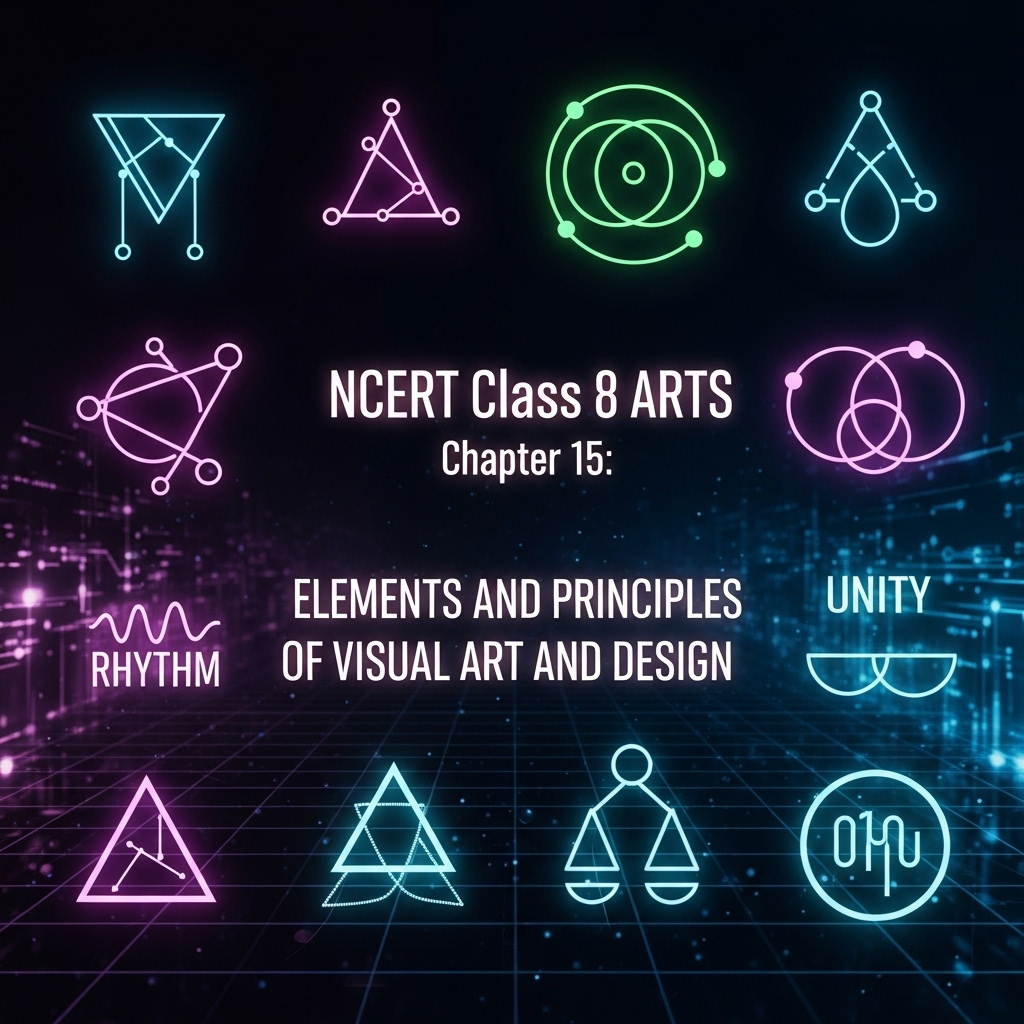Chapter Overview
5
Basic Colors
4
Classroom Requirements
9
Pedagogy Points
8
Learning Outcomes
What You'll Learn
Basic Colors
Understanding five primary colors and creating more through imagination.
Classroom Setup
Requirements for space, light, storage, and exhibition in visual arts class.
Pedagogy
Teaching methods using storytelling, original ideas, exploration, and community involvement.
Assessment
Competencies and outcomes for middle stage visual arts education.
Historical Context
The chapter draws from Chitrasutra of Vishnudharmottara Purana, emphasizing color creation. It provides guidance for teachers to enhance visual arts education in middle school, focusing on creativity, cultural awareness, and inclusive practices.
Key Highlights
Encourages original artwork inspired by life experiences; promotes collaboration, exploration, and care for materials; includes field trips and artist interactions; assesses through exhibitions, discussions, and self-evaluation.
Comprehensive Chapter Summary
1. Chitrasutra Shloka
From Adhyaya 40, Chitrasutra of Vishnudharmottara Purana: Five basic colors (white, yellow, red, blue, black); hundreds/thousands more by combining with imagination/discretion.
2. Note to Teachers
Classroom Requirements
Adequate space, light/ventilation, organized storage/access to materials/tools/stationery/audio-visual, exhibition space.
Visual Arts Pedagogy
Use storytelling/examples; encourage original ideas/emotions; motivate original artwork from observations; allow exploration/experiment/collaboration/dialogues; include outdoor/trips; organize museum/heritage/mela visits; invite artists/craftspersons; inculcate cleaning habits; encourage participation in displays/exhibitions.
Learning Outcomes
Table with CG C outcomes: Exhibit artworks/share ideas (1.1); cooperate in decisions (1.2); address stereotypes (2.1); use/clean/store materials (3.1); discuss art/experiences (4.1); use terminology (4.2); overall participation.
3. Middle Stage Competencies
C-1.1 to C-4.2
Express experiences through forms; collaborate flexibly; create artwork challenging stereotypes; connect imagery with experiences; use materials carefully; refine ideas/techniques; familiarity with local arts; describe local artists.
Star Activities
Facilitated by any teacher, even limited resources.
Questions and Answers from Chapter
Short Questions
Q1. What are the five basic colors?
Answer: White, yellow, red, blue, black.
Q2. From which text is the shloka?
Answer: Chitrasutra of Vishnudharmottara Purana.
Q3. What chapter is the shloka from?
Answer: Adhyaya 40.
Q4. What is the first classroom requirement?
Answer: Adequate space.
Q5. What is the second requirement?
Answer: Sufficient light and ventilation.
Q6. What for storage?
Answer: Organized storage and easy access to materials.
Q7. What space for exhibiting?
Answer: Space for showcasing artwork periodically.
Q8. First pedagogy point?
Answer: Use storytelling and examples.
Q9. Second pedagogy?
Answer: Encourage original ideas and curiosities.
Q10. Third pedagogy?
Answer: Motivate original artwork from observations.
Q11. Fourth pedagogy?
Answer: Allow exploration and dialogues.
Q12. Fifth pedagogy?
Answer: Include outdoor activities and trips.
Q13. Sixth pedagogy?
Answer: Organize visits to museums and melas.
Q14. Seventh pedagogy?
Answer: Invite local artists for sessions.
Q15. Eighth pedagogy?
Answer: Inculcate cleaning habits.
Medium Questions
Q1. Explain creating colors from basics.
Answer: Combine primary colors using imagination to make hundreds or thousands. (3 marks)
Q2. Describe classroom space need.
Answer: Adequate for comfortable work, light/ventilation, storage/access, exhibition space. (3 marks)
Q3. What for storytelling in pedagogy?
Answer: Introduce concepts/processes with everyday examples. (3 marks)
Q4. Explain encouraging original ideas.
Answer: Freely express ideas/imaginations/emotions/curiosities in artwork. (3 marks)
Q5. Motivate original artwork how?
Answer: Inspired by observations/experiences, not copying. (3 marks)
Q6. Allow what in classroom?
Answer: Explore/investigate/experiment/collaborate/dialogues. (3 marks)
Q7. Include what activities?
Answer: Outdoor/field trips to observe life/culture. (3 marks)
Q8. Organize what visits?
Answer: Museums/heritage monuments/melas. (3 marks)
Q9. Invite whom for sessions?
Answer: Local artists/craftspersons for interactive/workshops. (3 marks)
Q10. Inculcate what habits?
Answer: Cleaning after work, maintaining materials. (3 marks)
Q11. Encourage participation in what?
Answer: Selecting artwork for display/exhibitions. (3 marks)
Q12. What is C-1.1?
Answer: Expresses personal/everyday experiences through forms. (3 marks)
Q13. What is C-2.1?
Answer: Creates artwork challenging stereotypes. (3 marks)
Q14. What is C-3.1?
Answer: Demonstrates care/choices in materials/tools. (3 marks)
Q15. What is C-4.1?
Answer: Familiarity with local/regional arts. (3 marks)
Long Questions
Q1. Discuss combining colors from Chitrasutra.
Answer: Five basics: white, yellow, red, blue, black; hundreds others; combine primaries with imagination/discretion for hundreds/thousands.
Q2. Explain visual arts classroom requirements.
Answer: Adequate space for work; sufficient light/ventilation; organized storage/easy access to materials/tools/stationery/audio-visual; space for showcasing/exhibiting artwork periodically.
Q3. Describe visual arts pedagogy points.
Answer: Use storytelling/examples introduce concepts; encourage free expression ideas/emotions; motivate original artwork from observations/experiences; allow exploration/experiment/collaboration/dialogues; include outdoor/trips observe life/culture; organize museum/heritage/mela visits; invite artists/craftspersons interactive/workshops; inculcate cleaning/put back/maintain materials; encourage participation/decision-making selecting artwork displays/exhibitions.
Q4. Analyze learning outcomes table.
Answer: CG C: 1.1 Exhibit artworks/share ideas/feelings/processes; 1.2 Cooperate/contribute decisions; 2.1 Address stereotypes thinking/making artwork; 3.1 Carefully use/clean/store materials organized; 4.1 Discuss art/connection everyday experiences; 4.2 Use terminology discussing/writing artwork; overall participation classroom activities.
Q5. Discuss middle stage competencies.
Answer: C-1.1 Express personal/everyday experiences confidently forms; C-1.2 Demonstrate flexibility collaboratively developing practice; C-2.1 Create artwork based situations/stories challenge stereotypes; C-2.2 Connect imagery/symbols/metaphors personal experiences/emotions/imaginations; C-3.1 Demonstrate care/informed choices materials/tools/techniques; C-3.2 Refine ideas/techniques planning to presentation/review process; C-4.1 Demonstrate familiarity local/regional arts; C-4.2 Describe life/work few local artists region/across India.
Q6. Explain star symbol activities.
Answer: Marked activities facilitated any teacher, even schools limited resources.
Q7. How modify activities?
Answer: Modify chapters' activities suit local context/specific needs students.
Q8. What for every student experience?
Answer: Create best learning experience every student points kept mind.
Q9. Discuss assessment based on competencies.
Answer: Visual arts assessment based middle stage competencies C-1.1 to C-4.2.
Q10. Explain C-1.1 and C-1.2.
Answer: C-1.1: Expresses personal/everyday life experiences confidently various visual art forms; C-1.2: Demonstrates flexibility process collaboratively developing visual arts practice.
Q11. Describe C-2.1 and C-2.2.
Answer: C-2.1: Creates visual artwork based situations/stories challenge stereotypes surroundings (gender roles); C-2.2: Connects visual imagery/symbols/visual metaphors personal experiences/emotions/imaginations.
Q12. Explain C-3.1 and C-3.2.
Answer: C-3.1: Demonstrates care/makes informed choices using various materials/tools/techniques visual arts; C-3.2: Refines ideas/techniques visual expression planning to final presentation/reviewing process.
Q13. Describe C-4.1 and C-4.2.
Answer: C-4.1: Demonstrates familiarity various local/regional forms art; C-4.2: Describes life/work few local artists region/across India.
Q14. How strengthen knowledge?
Answer: Chapters strengthen knowledge visual fundamentals, develop artistic skills/cultural awareness.
Q15. What for audio-visual facilities?
Answer: Storage/easy access art materials/tools/basic stationery/audio-visual facilities.




